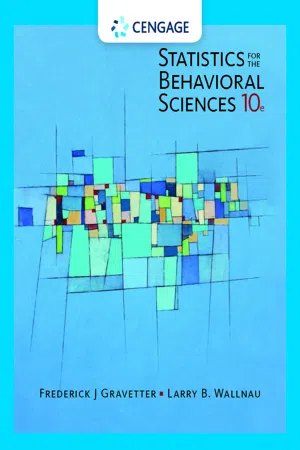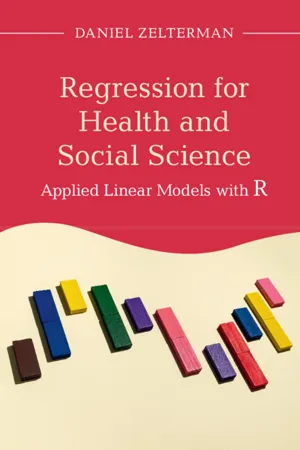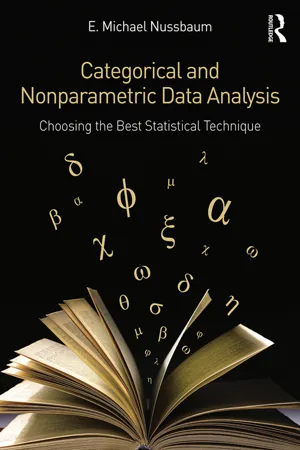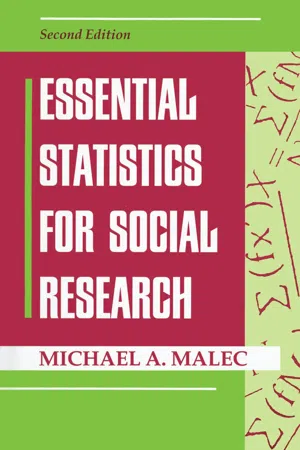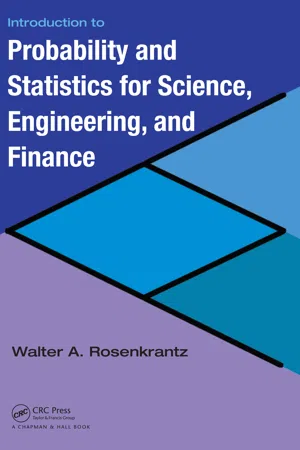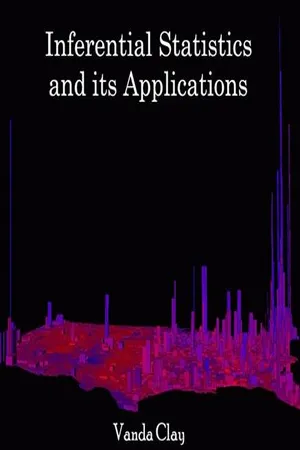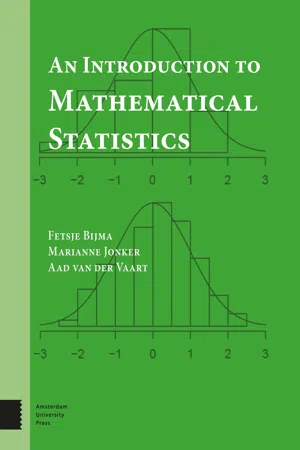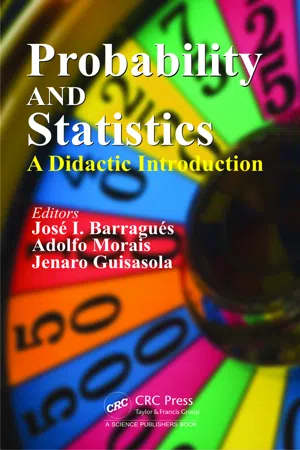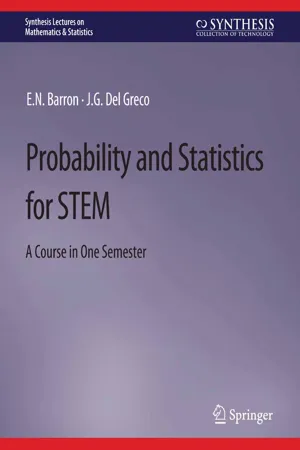Mathematics
Binomial Hypothesis Test
A binomial hypothesis test is a statistical method used to determine if the proportion of successes in a sample is significantly different from a hypothesized proportion. It involves calculating the probability of observing the sample results or more extreme results, assuming the null hypothesis is true. The test is commonly used in various fields to make inferences about proportions and probabilities.
Written by Perlego with AI-assistance
Related key terms
1 of 5
12 Key excerpts on "Binomial Hypothesis Test"
- eBook - PDF
- Frederick Gravetter, Larry Wallnau(Authors)
- 2016(Publication Date)
- Cengage Learning EMEA(Publisher)
college class: freshman, sophomore, junior, senior d. registered voter: yes, no LEARNING CHECK SECTION 18.1 | Introduction to the Binomial Test 607 Copyright 2017 Cengage Learning. All Rights Reserved. May not be copied, scanned, or duplicated, in whole or in part. Due to electronic rights, some third party content may be suppressed from the eBook and/or eChapter(s). Editorial review has deemed that any suppressed content does not materially affect the overall learning experience. Cengage Learning reserves the right to remove additional content at any time if subsequent rights restrictions require it. 18.2 An Example of the Binomial Test 3. Perform all of the necessary computations for the binomial test. 4. Explain how the decision in a binomial test can be influenced by the fact that each score actually corresponds to an interval in the distribution. The binomial test follows the same four-step procedure presented earlier with other exam-ples for hypothesis testing. The four steps are summarized as follows. State the hypotheses. In the binomial test, the null hypothesis specifies values for the population proportions p and q . Typically, H 0 specifies a value only for p , the proportion associated with category A . The value of q is directly determined from p by the relationship q = 1 − p . Finally, you should realize that the hypothesis, as always, addresses the prob-abilities or proportions for the population . Although we use a sample to test the hypothesis, the hypothesis itself always concerns a population. Locate the critical region. When both values for pn and qn are greater than or equal to 10, the z -scores defined by Equation 18.1 or 18.2 form an approximately normal distribu-tion. Thus, the unit normal table can be used to find the boundaries for the critical region. With α = .05, for example, you may recall that the critical region is defined as z -score values greater than + 1.96 or less than − 1.96. - eBook - PDF
- Mohammed Meah(Author)
- 2022(Publication Date)
- Wiley(Publisher)
There are two main types of hypothesis. Null Hypothesis This states that there will be no significant difference between the conditions, i.e. mean of sample 1 = mean of sample 2. This is our control hypothesis in that we are saying there will be no significant effect. Alternate Hypothesis There is a significant difference in the means of the two conditions, i.e. mean of sample 1 is greater than or less than mean of sample 2. This is our experimental hy- pothesis which states that there will be a significant difference between conditions. A significant effect or difference (see below) is a change that did not occur by chance, i.e. the chance of it happening is rare. This prediction of something happen- ing is called probability and is crucial to accepting or rejecting a hypothesis. Probability To test the above hypothesis, we need to understand probability. Probability is the chance of something happening, it is defined between 0 and 1, where 1 represents 100% that it will occur (i.e. certain to occur) or zero, 100% that it won’t occur. When we toss a coin there is a 50% chance of getting a head or tail (only two choices, heads or tails, i.e. 1/2 = 50%). However, if we toss a dice with six sides labelled 1 to 6, the proba- bility of getting a number between 1 and 6 is 16.7% (six choices, 1/6 = 16.7%). To cover all the possible probabilities if we used 2 coins, or 3 coins or 50 coins we would have to do many experiments of tossing the coins to work out the frequency distributions. Distributions Historically (Appendix 1), probabilities have been worked out and frequency distributions (e.g. binomial, normal, Poisson distributions) have been produced from sample data (e.g. gambling). These sample probability distributions are useful in pre- dicting outcomes and are crucial to hypothesis testing. “The most important questions of life are, for the most part, really only problems of probability”. - eBook - PDF
- Myles Hollander, Douglas A. Wolfe, Eric Chicken(Authors)
- 2013(Publication Date)
- Wiley(Publisher)
Chapter 2 The Dichotomous Data Problem INTRODUCTION In this chapter the primary focus is on the dichotomous data problem. The data consists of n independent repeated Bernoulli trials having constant probability of success p . On the basis of these outcomes, we wish to make inferences about p . Section 2.1 introduces the binomial distribution and presents a binomial test for the hypothesis p = p 0 , where p 0 is a specified success probability. Section 2.2 gives a point estimator p for p . Section 2.3 presents confidence intervals for p . Section 2.3 also contains the generalization of the binomial distribution to the multinomial distribution, confidence intervals for multinomial probabilities and a test that the multinomial probabilities are equal to specified values. Section 2.4 presents Bayesian competitors to the frequentist estimator p of Section 2.2. The Bayesian estimators incorporate prior information. Data. We observe the outcomes of n independent repeated Bernoulli trials. Assumptions A1. The outcome of each trial can be classified as a success or a failure. A2. The probability of a success, denoted by p , remains constant from trial to trial. A3. The n trials are independent. 2.1 A BINOMIAL TEST Procedure To test H 0 : p = p 0 , (2.1) where p 0 is some specified number, 0 < p 0 < 1, set B = number of successes. (2.2) a. One-Sided Upper-Tail Test. To test H 0 : p = p 0 Nonparametric Statistical Methods , Third Edition. Myles Hollander, Douglas A. Wolfe, Eric Chicken. © 2014 John Wiley & Sons, Inc. Published 2014 by John Wiley & Sons, Inc. 11 12 Chapter 2 The Dichotomous Data Problem versus H 1 : p > p 0 at the α level of significance, Reject H 0 if B ≥ b α ; otherwise do not reject, (2.3) where the constant b α is chosen to make the type I error probability equal to α . The number b α is the upper α percentile point of the binomial distribution with sample size n and success probability p 0 . - eBook - PDF
Regression for Health and Social Science
Applied Linear Models with R
- Daniel Zelterman(Author)
- 2022(Publication Date)
- Cambridge University Press(Publisher)
2.4 Hypothesis Tests One of the important roles of statistics is to provide convincing evidence of the validity (or falsity) of a certain claim about the nonobservable state of nature. Of course, statistical variability prevents us from saying a statement is 100% true, because we might just have observed an unusual sample of data. If we were only able to measure the heights of basketball players, for example, a reasonable conclusion would be all people are over six feet tall. Even if we can safely assume our data is representative of the population, we still need to qualify our language with a certain measure of doubt about our conclusions. This is the framework of the hypothesis test. You can think of a hypothesis test as a game we play with nature. We are presented with a choice of two different complementary statements about reality, referred to as hypotheses. Our job is to decide which is the true statement. Unlike a poker game, where we might have to risk a large sum of money in order to see if the other player is bluffing, in hypothesis testing we will never know if we made the correct decision. The objective is to pick the correct decision with high probability, even though we will never know with certainty which is correct. Figure 2.5 is a convenient way to illustrate all of the possible outcomes. More specifically, a hypothesis test begins with a null hypothesis and a correspond- ing alternative hypothesis. The null hypothesis is typically a statement about the status quo, the way things are today. Examples might include stating a new way of doing things is no better or worse than the way we have been doing it all along. The new “Drug A” is the same as the standard treatment. “Brand X” detergent will get your clothes as clean as “Brand Y.” These are examples of typical null hypotheses. The alternative hypothesis is sometimes the opposite of the null hypothesis, so we might say Drug A is better or Brand X detergent makes clothes cleaner. - Available until 25 Jan |Learn more
Categorical and Nonparametric Data Analysis
Choosing the Best Statistical Technique
- E. Michael Nussbaum(Author)
- 2014(Publication Date)
- Routledge(Publisher)
π is, our CI ranges from 39% to 94%. This interval is wide because we used such a small sample. With such little precision, what good is the binomial test?Applications of the Binomial Test
Fortunately, statisticians have developed several applications of the binomial test that are more compelling than the previous example.Is π Different From Another Population Mean?Suppose that for high schools in a certain state, the statewide graduation rate is 70%. At the Excelier Academy, however, the graduation rate is 75% (n = 100). Is the graduation rate at Excelier significantly different from the statewide average?To answer this question, we need to suppose that the students at Excelier represent a random sample from the general population. This assumption may not be reasonable, because Excelier is a charter school and the parents of the students specifically chose to send their children to Excelier. However, it is this very assumption that we are testing. The null hypothesis assumes that the students are a random sample; the alternative hypothesis reflects that the sample is not representative of the general population, either because of selection effects or because the teaching at Excelier makes the students special (i.e., less likely to drop out).Because we are assuming that the students at Excelier represent a random sample, there is a sampling distribution with mean π . The null and alternative hypotheses are H 0 : π = 70%; H a : π ¹ 70%. Let us set alpha to .05. P in this case is 75%. The one-tailed probability of obtaining P under the null, where π - eBook - PDF
Essential Statistics For Social Research
Second Edition
- Michael Malec(Author)
- 2018(Publication Date)
- Routledge(Publisher)
The Probability of Observing a Given Number of Heads When Twenty Coins Are Tossed Probability and Hypothesis Testing 93 Probability and the Logic of Hypothesis Testing Let us now develop what we have learned thus far into some general principles for conducting statistical tests of hypotheses. Our first task will be to select an appropriate hypothesis. There can be a variety of hypotheses for any research problem. In tossing twenty coins we could hypothesize (1) the outcome will be ten heads, (2) the outcome will be eleven heads, or (3) the outcome will be between eight and twelve heads, and so on. Any of these alternative hypotheses are plausible, but, statistically speaking, most are very difficult to test. (The reason for this difficulty is beyond the scope of this discussion.) There is, however, one general hypothesis that we can test. It is the hypothesis that says that the observed event occurs in conformity with a chance model. For example, Figure 5.1 describes a chance model of the possible outcomes when twenty coins are tossed. Of specific interest, this chance model tells us that the mean number of heads when twenty coins are tossed is ten. We can then formulate the following research question: Is the number of heads actually observed reasonably similar to the number of heads that we should expect to observe? Stated more formally, because the true population mean is 10, we hypothesize that our sample mean will also be 10. This type of statement, which says that the sample value is no different from the population value, is called a null hypothesis (Ho), or the hypothesis of no difference. But the practical meaning of the term null hypothesis lies in the fact that it is the hypothesis we hope to nullify, that is, to disprove. Strictly speaking, the null hypothesis is the only hypothesis that can be statistically tested. For our example, the null hypothesis might be stated in any of the following ways: 1. - Walter A. Rosenkrantz(Author)
- 2008(Publication Date)
- CRC Press(Publisher)
Chapter 8 Hypothesis Testing Doubt everything or believe everything; these are two equally convenient strategies. With either we dispense with the need for reflection. Henri Poincar´ e (1854-1912), French mathematician 8.1 Orientation A frequently occurring problem of no small importance is to determine whether or not a product meets a standard. The quality of the product is usually measured by a quantitative variable X defined on a population. Since the quality of the product is always subject to some kind of random variation, the standard is usually expressed as an assertion about the distribution of the variable X. For example, suppose X denotes the fuel efficiency of a car [measured in miles per gallon (mpg)], and the fuel efficiency standard is that the mean mpg µ be greater than µ 0 . The assertion that µ > µ 0 is an example of a statistical hypothesis ; it is a claim about the distribution of the variable X . For another example, consider the widely used Black-Scholes options pricing formula, which assumes that returns on a stock are normally distributed (see Section 5.9.1). Is this hypothesis consistent with the kinds of actual data listed in Tables 1.19 and 1.20? Problems of this sort are discussed in Section 8.4. In this chapter we learn how to use statistics such as the sample mean and sample variance to test the truth or falsity of a statistical hypothesis. We then extend these methods to testing hypotheses about two distributions where the goal is to study the difference between their means. Organization of Chapter 1. Section 8.2: Tests of Statistical Hypotheses: Basic Concepts and Examples 2. Section 8.2.1: Significance Testing 3. Section 8.2.2: Power Function and Sample Size 4. Section 8.3: Comparing Two Populations 5. Section 8.3.1: The Wilcoxon Rank Sum Test for Two Independent Samples 6. Section 8.3.2: A Test of the Equality of Two Variances 7.- eBook - PDF
- Ian C. Marschner(Author)
- 2014(Publication Date)
- Chapman and Hall/CRC(Publisher)
5 Hypothesis testing concepts In Chapter 2 we discussed using confidence intervals to conclude whether or not particular values of the parameter are plausible. This introduced us to the notion of hypothesis testing, the principles of which will be developed in the next two chapters. In this chapter we will discuss some of the basic concepts in hypothesis testing, including significance level, power and P -values, and further discuss the connection between hypothesis testing and confidence intervals. Chapter 6 will then make use of these concepts to develop general methods for carrying out hypothesis tests based on the likelihood function. Our discussion in this chapter and the next will present hypothesis tests as rules for deciding whether an hypothesis should be rejected or not, based on the observed sample. This is useful for assessing the statistical significance of observed departures from the hypothesis, but reliance on a simple dichotomy can often lead to misinterpretation, so we will also discuss the importance of viewing hypothesis testing as complementary to the process of confidence interval estimation. These notions will be illustrated using an extended example involving randomised treatment comparisons. 5.1 Hypotheses In most biostatistical contexts involving hypothesis testing, one is interested in as-sessing whether there is evidence that a particular factor has an effect on some health outcome. In practice, the term “effect” is often used loosely to encompass both sit-uations that truly are the assessment of the effect of a factor, such as a randomised trial of an intervention, and situations involving only the assessment of associations, such as an observational study of a particular exposure. In either situation, statistical hypothesis testing begins with the development of a probability model, as was used in our discussions on parameter estimation. - No longer available |Learn more
- (Author)
- 2014(Publication Date)
- Orange Apple(Publisher)
________________________ WORLD TECHNOLOGIES ________________________ Chapter- 2 Statistical Hypothesis Testing A statistical hypothesis test is a method of making decisions using experimental data. In statistics, a result is called statistically significant if it is unlikely to have occurred by chance. The phrase test of significance was coined by Ronald Fisher: Critical tests of this kind may be called tests of significance, and when such tests are available we may discover whether a second sample is or is not significantly different from the first. Hypothesis testing is sometimes called confirmatory data analysis , in contrast to exploratory data analysis. In frequency probability, these decisions are almost always made using null-hypothesis tests (i.e., tests that answer the question Assuming that the null hypothesis is true, what is the probability of observing a value for the test statistic that is at least as extreme as the value that was actually observed? ) One use of hypothesis testing is deciding whether experimental results contain enough information to cast doubt on conventional wisdom. Statistical hypothesis testing is a key technique of frequentist statistical inference, and is widely used, but also much criticized. While controversial, the Bayesian approach to hypothesis testing is to base rejection of the hypothesis on the posterior probability. Other approaches to reaching a decision based on data are available via decision theory and optimal decisions. The critical region of a hypothesis test is the set of all outcomes which, if they occur, will lead us to decide that there is a difference. That is, cause the null hypothesis to be rejected in favor of the alternative hypothesis. The critical region is usually denoted by C. Examples The following examples should solidify these ideas. Example 1 - Court Room Trial A statistical test procedure is comparable to a trial; a defendant is considered not guilty as long as his guilt is not proven. - No longer available |Learn more
- Fetsje Bijma, Marianne Jonker, Aad van der Vaart, Reinie Erné(Authors)
- 2017(Publication Date)
- Amsterdam University Press(Publisher)
2 , instead of the hypothesis that p 2 − p 1 > 0 . The value 0 . 2 could then express the practical significance. In practice, however, we are usually satisfied with determining a qualitative di ff erence and test the hypothesis H 1 : p 2 − p 1 > 0 . 4.6 Some Standard Tests In this section, we discuss several tests that are frequently used, other than the Gauss test and binomial test. Most of these tests can be understood intuitively. For a given test problem, the general idea is to find a test statistic that is “reasonable” (often based on a good estimator for the parameter) and for which we can easily compute a critical value or p -value. For the latter, the probability distribution of the test statistic under the (“boundary” of the) null hypothesis must be either given in a table or computable. Often, however, the probability distribution under the null hypothesis does not belong to the usual list of computed distributions in probability theory. We can then introduce a new standard probability distribution and produce tables. An alternative is to approximate the probability distribution “on-the-fly” using stochastic simulation. Let us discuss examples of both approaches. 127 4: Hypothesis Testing We begin this section with a discussion of the two most important random probability distributions, the chi-square and t -distributions. These families of prob-ability distributions are both related to the normal distribution and occur both when testing the parameters of the normal distribution and when carrying out approximations in large samples. 4.6.1 Chi-Square and t -Distribution The chi-square and t -distributions are continuous probability distributions whose densities are given by relatively simple expressions. For our purpose, however, the following structural definitions of these probability distributions are more appealing. - eBook - PDF
Probability and Statistics
A Didactic Introduction
- José I. Barragués, Adolfo Morais, Jenaro Guisasola, José I. Barragués, Adolfo Morais, Jenaro Guisasola(Authors)
- 2016(Publication Date)
- CRC Press(Publisher)
Students may suggest as to why it could be useful to compare the variances of two normal distributions (Gallagher 2006) and then carry out such a test using the F distribution (Spiegel and Stephens 1999). It is also possible to take things further by considering non-parametric tests such as the Wilcoxon rank-sum test (Spiegel and Stephens 1999). As a further point of interest, readers might like to consider, in the context of the work in this chapter, a psychological phenomenon known as ‘belief bias’ (Kaplan 2009), in which subjects rate the strength of arguments based on their own personal view regarding the believability of the conclusions. In particular, the subjects in this study were more likely to question the experimental design when they did not believe the conclusions reached by the hypothesis test. Hypothesis Testing is an aspect of classical statistics with a rich history. Many of the ideas were developed in the first half of the twentieth century by Ronald Fisher and Jerzy Neyman (Lehmann 2011). Familiarity with the historical aspects of mathematics and statistics allows students to gain a broad overview of these disciplines. Mixed Problems 1. A parcel delivery company claims that at least 75% of the parcels they deal with reach their destination within 48 hrs of posting. A survey was carried out to test this claim, and out of a random selection of 150 parcels, 104 were found to have arrived within 48 hrs of posting. Test the company’s claim at the 5% significance level, stating any assumptions and approximations that you make in your calculations. 290 Probability and Statistics HINT: The claim involves the phrase “at least”. The alternative hypothesis will thus involve the phrase “less than”. 2. A survey was carried out to compare the sales of The Hobbit in bookshops situated across the Atlantic from one another. A random selection of 50 bookshops in Chicago was made, and similarly of London. - eBook - PDF
Probability and Statistics for STEM
A Course in One Semester
- E.N. Barron, J.G. Del Greco, E. N. Barron, J. G. Del Greco(Authors)
- 2022(Publication Date)
- Springer(Publisher)
Tables summarizing all the tests for the normal parameters and the binomial proportion are located in Section 5.8. 5.5 POWER OF TESTS OF HYPOTHESES The power of a statistical test refers to its ability to avoid making Type II errors, that is, not rejecting the null hypothesis when it is false. Recall that the probability of making a Type I or Type II error is denoted ˛ and ˇ, respectively. Specifically, we have ˛ D P.rejecting H 0 j H 0 is true/ and ˇ D P.not rejecting H 0 j H 1 is true/. In order to quantify the power of a test, we need to be more specific with the alternative hy- pothesis. Therefore, for each # 1 specified in an alternative H 1 W # D # 1 , we obtain a different value of ˇ. Consequently, ˇ is really a function of the # which we specify in the alternative. We define for each # 1 ¤ # 0 ; ˇ.# 1 / D P.not rejecting H 0 j H 1 W # D # 1 ¤ # 0 /: Definition 5.16 The power of a statistical test at a value # 1 ¤ # 0 is defined to be .# 1 / D 1 ˇ.# 1 / D P.rejecting H 0 j H 1 W # D # 1 ¤ # 0 /: The power of a test is the probability of correctly rejecting a false null. For reasons that will become clear later, we may define .# 0 / D ˛. We now consider the problem of how to compute .#/ for different values of # ¤ # 0 . To illustrate the procedure in a particular case, suppose we take a random sample of size n from a random variable X N. ; 0 /. ( 0 is known.) Consider the set of hypotheses H 0 W D 0 vs. H 1 W ¤ 0 : 124 5. HYPOTHESIS TESTING Recall that we reject H 0 if j x 0 0 = p n j z ˛=2 : If, in fact, D 1 ¤ 0 , the probability of a Type II error is ˇ. 1 / D P.not rejecting H 0 j D 1 / (5.6) D P ˇ ˇ ˇ ˇ ˇ X 0 0 = p n ˇ ˇ ˇ ˇ ˇ < z ˛=2 j D 1 ! D P 0 z ˛=2 0 p n < X < 0 C z ˛=2 0 p n j D 1 D P . 0 1 / 0 = p n z ˛=2 < X 1 0 = p n < . 0 1 / 0 = p n C z ˛=2 j D 1 ! D P .
Index pages curate the most relevant extracts from our library of academic textbooks. They’ve been created using an in-house natural language model (NLM), each adding context and meaning to key research topics.
